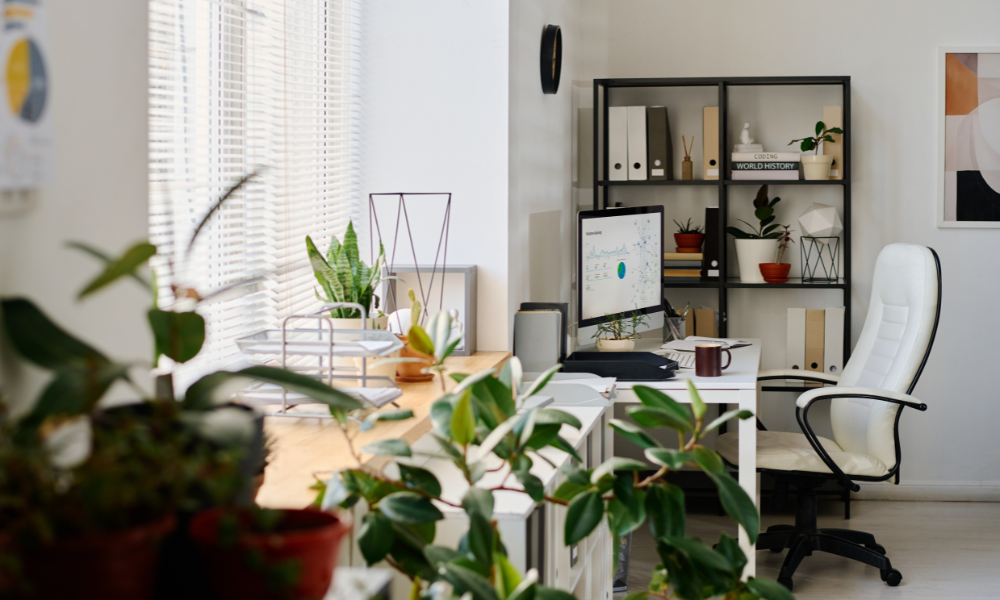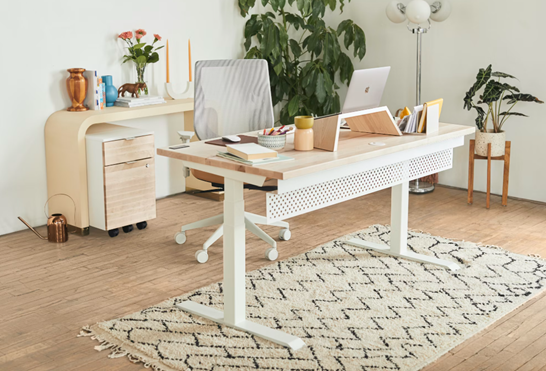
Discover the ideal work-from-home setup for your remote employees. Learn how to boost productivity, well-being, and efficiency with expert tips and strategies

Employers have a duty of care to their employees, whether they work on-site or at home. Making sure that teams have the tools they need to do their work and stay healthy is part of this duty.
In this article, we’ll discuss what makes an ideal work from home setup. We’ll make a list of important tech equipment and essential tools to make home office work best for employees. We’ll also suggest some ways that employers can support their teams in setting up their workspaces at home.
This is perfect for HR leaders and their teams. Consider sharing this more widely via induction packs and employee handbooks for your remote workers.
The best work from home setup has all the tools that employees need to do their job well. This will look different for each person, depending on the nature of their work. The basics are:
Important points to consider are the worker’s health and well-being in planning a work from home setup. Read this article for more on managing remote workers.
Making sure that the home office is comfortable and healthy for remote workers is a joint responsibility between you and the employee. Sharing these guidelines with them is an important first step.
Here are some office equipment to support your employees’ health at home:
Sitting is the new smoking, as the saying goes. Studies have shown a link between sitting for long periods and health concerns like obesity. A standing desk can help with these issues.
Some benefits of using a standing desk:
Not all tasks, though, should be done at standing desks. Creative work like writing or graphic design is best done when seated.
Ergonomics refers to products that conform to the natural shape of the human body. A good ergonomic chair should have these features:
The US Occupational Health and Safety Administration has detailed guidelines for office chairs.
Many employers issue laptops to their remote workforce to give them flexibility in where they work. A good work from home office setup should include a laptop stand.
Using a laptop stand brings the laptop screen higher, avoiding eye strain and neck and back issues. The screen should be at eye level and at least an arm’s length away.
Here are more tips on making full use of ergonomics when working at home.
These are the tools of the trade for every remote worker. These are the basics; employers are free to scale up depending on the needs of their work-from-home teams:
Laptops are a popular choice among remote workers. They’re easy to stow away when the work is done. They’re also easy to pack if the employee prefers to work elsewhere, like a cafe or co-working space.
The features and specs for work laptops will depend on the nature of work. A good starting point would be:
Other accessories like a docking station are worthy investments as well.

If your employee decides to use a laptop stand, they should also get an external keyboard and mouse. This way, they can continue using the laptop even while it’s at arm’s length from where they sit.
It would be ideal for employees to use an ergonomic keyboard and mouse, especially if their work involves a lot of data entry.
A strong, reliable internet connection is a must for a productive home office. Employers may consider options like a battery-powered hotspot or a mobile data plan. These will help maintain connectivity during rare service interruptions or emergencies.
This tool protects your home office equipment from sudden voltage spikes, which can happen during storms or unexpected power outages.
We suggest choosing a power strip with USB charging options to connect multiple gadgets. It also keeps the workplace tidy and organized.
The active noise cancellation feature in these types of headphones helps minimize background noise. It’s perfect for those who require focus and concentration for deep work. It’s also an essential tool for those who lead virtual meetings and video calls.
Let’s start with the basics: stationery, home office furniture, personal items. Nothing fancy here – just functional yet personal touches to add to the space:
Yes, notepads, pencils, pens are number one on the list of basics for work-from-home setups. Using analog tools in a digital world offers several benefits:
Writing and doodling using pen and paper also provide a refreshing break from using keyboards and screens.
Speaking of analog, many of us still use paper forms and documents. Having a filing cabinet as part of a home office set up helps keep paper files organized.
According to the Mayo Clinic, we should be drinking around 12 to 16 cups of fluids daily. Every work from home set up should include a small pitcher or bottle as a reminder to drink water.
Why would we suggest a small pitcher or bottle? This encourages your employee to get up several times during the day to get a refill.
Drinking plenty of water is good for the spine, which is under the most pressure from long hours of sitting.
Getting up every 20 minutes to walk or stretch is good for the back. Many swear by the Pomodoro technique as a good productivity hack.
Your teams can get creative here: they can use an hourglass, a timer on their phone, or a Pomodoro timer (yes, there is such a thing).
Essential oils have a range of health benefits. Peppermint and lemon, for example, have been known to help with focus and concentration. Lavender oil, meanwhile, helps with relaxation.
Using an essential oils diffuser can help freshen any workspace. Diffusers come in a variety of shapes and sizes, so they can also serve as decor for the space.
Some pops of green help improve one’s mood and well-being, especially if the home office does not have a window. Some varieties like spider plants, snake plants, and peace lily also help purify the air.
Sitting for hours compresses the spine, so getting up to walk or stretch is ideal. Having a yoga mat nearby is a reminder to take a few minutes to relax and stretch:
Remote employees could benefit from some support in setting up their office space at home. Here are some ways that employers can help:
You can allocate a fixed amount per employee for purchasing work from home essentials. Refer to the list earlier in this article for some ideas.
In this scenario, employees submit receipts for the purchase of desks, chairs, and other tools. You can set certain conditions and limits. Outline these clearly in a set of guidelines in the employee handbook and onboarding kit.
This involves sourcing and buying the equipment, then shipping it to your employees.
The pros:
The cons:
Conduct a cost-benefit analysis to help you choose the best option. Go over potential costs, assess the benefits, then compare options.
Some of the top remote companies offer financial support – read the article for more details on how they did it.
It makes complete sense to cover a portion of your remote employees’ internet and utility bills. They spend eight hours each day working, using resources at home. Offer to reimburse a set amount or issue a flat stipend monthly.
Work with establishments that can offer your employees discounts when they purchase furniture, tools, and equipment. Go with a local brick-and-mortar store with branches across the country. Another option is partnering with a reputable online seller.

Offer interest-free loans to support employees with huge expenses such as home office renovations or upgrades. You can also work out payroll deductions to pay back any advances made toward these expenses.
Having to repair or renovate a home space is a huge expense, resulting in financial stress. Helping out your employees through a loan or flexible repayment scheme is a big load off their shoulders. This helps ensure productivity, financial well-being, and overall happiness of your workforce.
If your employees don’t know where to begin with their work from home setup, arrange a session with an interior designer or an ergonomics expert. Arrange a webinar where one of these professionals covers the basics of a home office setup.
This is a creative way to make sure that your employees keep safety and comfort in mind when arranging their workspace.
Once your organization has decided on how to support work from home setups...put that in writing! Draft a remote work policy outlining financial support options and other details. Continue to refine and update the policy as needed.
To help you get started, here’s a guide on creating a remote work policy.
Family life and work life tend to blur for employees who work at home. Allowing that to continue results in stress and burnout, which you don’t want for your employees.
HR leaders could encourage their remote workforce to create boundaries between work and home. Here are some ways to do that:
This could be a tiny space with a desk and chair near the kitchen or a small work area in the bedroom. Remote workers can have an imaginary line between the workspace and the rest of the house. Everything work-related is in that space only.
Mimic going to work by taking a shower, getting dressed, then heading to the home office. This helps set clear physical boundaries, especially in a small home.
Studies have shown that remote workers tend to work longer hours. This shouldn’t be the case. Encourage your employees to start and end on time.
Some remote workers do an activity after work to signal their commute home. They go for a run or walk the dog, for example. That tells their brain that the workday has ended, creating clear boundaries between work life and home life.
Encourage employees to turn off their work equipment at the end of working hours. Remind them to set up auto replies when they’re going on holiday.
The ideal home office setup varies based on a worker’s role, needs, and preferences. Essentials like tech equipment, ergonomic furniture, and useful gadgets lay the foundation. Adding personal touches such as a favorite plant or wellness items like a yoga mat result in more comfort and productivity.
Supporting employees in creating their home office by covering these expenses can make a meaningful difference. It boosts morale and supports a happier, more productive workforce – wherever they might be.
What do you think is the perfect work from home set up for your employees? Let us know in the comments